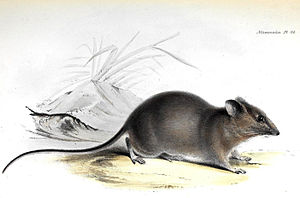Galápagos tortoiseshell rat
| Galápagos tortoiseshell rat | ||||||||||||
|---|---|---|---|---|---|---|---|---|---|---|---|---|

Galápagos tortoiseshell rat ( Aegialomys galapagoensis ) |
||||||||||||
| Systematics | ||||||||||||
|
||||||||||||
| Scientific name | ||||||||||||
| Aegialomys galapagoensis | ||||||||||||
| ( Waterhouse , 1839) |
The Galápagos tortoiseshell rice rat or Galápagos coastal rice rat ( Aegialomys galapagoensis ) is a rodent in the root family (Cricetidae). The species is endemic to the only 24 km² large island of Santa Fé , which is one of the Galapagos Islands .
Distribution and Taxonomy
In George Robert Waterhouse's first description of the species, it is stated that the holotype comes from Santa Cruz Island . Later expeditions found the Galápagos tortoiseshell rat only on the islands of Santa Fé and San Cristóbal , although the population on the latter island died out after a short time. The cause is considered to be competition from introduced rodents such as the house rat and house mouse . The populations on the two islands have occasionally been classified as separate species or subspecies.
- A. g. galapagoensis (Waterhouse, 1839) on San Cristóbal
- A. g. bauri (Allen, 1892) on Isla Santa Fé
In other papers, such as Mammal Species of the World , they are listed as synonyms .
Originally, the Galápagos tortoiseshell rat belonged to the genus of the actual rice rats ( Oryzomys ). According to a revision by Weksler et al. (2006) together with the yellow tortoiseshell rat ( Aegialomys xanthaeolus ) it forms the newly formed genus Aegialomys .
With the Galápagos rice rats ( Nesoryzomys ) another group of rodents is endemic to the Galapagos Islands. However, these do not live on Santa Fé.
features
The species resembles the actual rice rats in appearance. Females are smaller than males with a head-to-trunk length of about 108 mm and a weight of about 55 g. The latter are around 118 mm and weigh around 74 g. In addition, both sexes have an approximately equally long, narrow tail that is only sparsely covered with hair.
Way of life
The landscape of the island of Santa Fé resembles a desert with cacti and scattered trees. The highest point is 259 meters above sea level.
The Galápagos tortoiseshell rat is active from dusk until early morning and mostly hangs out on the ground. It feeds on insects, young plant shoots (e.g. species of the genus Cryptocarpus ) and fish scraps that fishermen drop on the ground. It is generally believed that this rodent, like the other rice rats, behaves opportunistically when foraging for food. The Galapagos buzzard ( Buteo galapagoensis ) and short-eared owl ( Asio flammeus ) are known to be natural enemies . There is also a documented case in which a millipede of the species Scolopendra galapagoensis captured a young animal.
There are different statements about mating behavior. According to one study, mating takes place in the warm months from January to May, while another study claims that litters can occur throughout the year. Usually a litter consists of three to five young animals that are naked and blind at birth. They open their eyes after about 9 days and start eating solid foods after about 13 days. With further details on reproduction, it is assumed that they correspond to the behavior of the actual rice rats. In these, females are pregnant for about 25 days and young animals are suckled for about two weeks. The oldest known specimens of the Galápagos tortoiseshell lived two years.
This rodent is believed to be responsible for the spread of the seeds of the balsam tree Bursera graveolens, like the Santa Fe glandular head ( Conolophus pallidus ) and some bird species . The existence of the tree was damaged by the browsing of domestic goats for about 60 years . After the goats were removed from the island in 1971, the number of trees increased again.
status
The population of the species is considered stable or slightly decreasing. Since the Galápagos tortoiseshell rat is restricted to a small distribution area, it is listed as endangered ( Vulnerable ) by the IUCN . It is especially important that no other rodents get to the island.
Individual evidence
- ↑ a b c Aegialomys galapagoensis in the IUCN Red List of Threatened Species 2015.3. Posted by: Tirira, D., Boada, C. & Weksler, M., 2008. Retrieved February 3, 2016.
- ^ Wilson & Reeder (eds.): Mammal Species of the World . 3. Edition. Johns Hopkins University Press, Baltimore 2005, ISBN 0-8018-8221-4 (English, Oryzomys galapagoensis ).
- ↑ Weksler, M., Percequillo, AR and Voss, RS 2006. Ten new genera of oryzomyine rodents (Cricetidae: Sigmodontinae) . American Museum Novitates 3537: 1-29.
- ↑ a b c d e f C. Wolf: Galapagos rice rat in the Animal Diversity Web of the University of Michigan Museum of Zoology. Retrieved February 3, 2016.